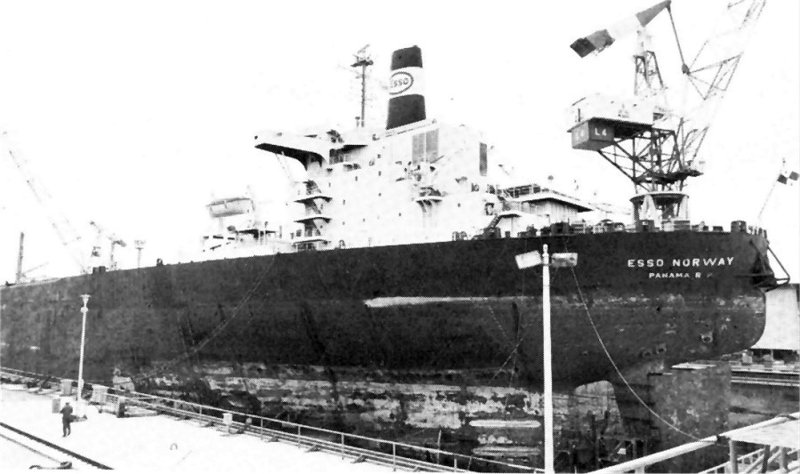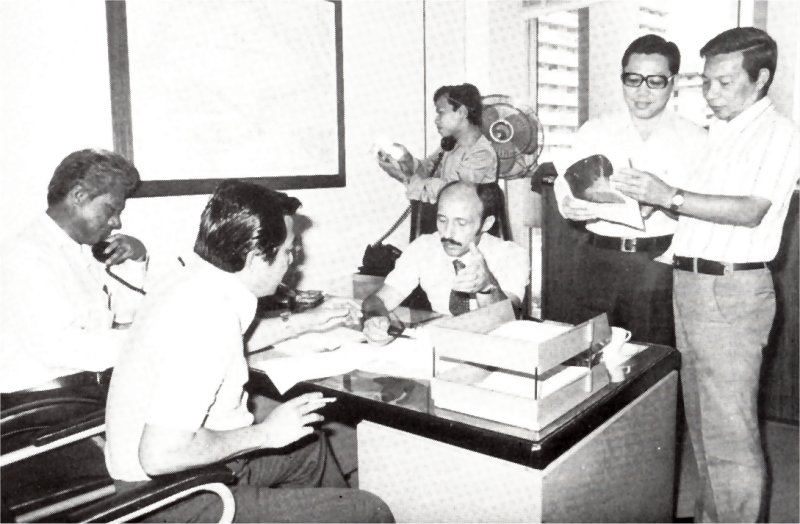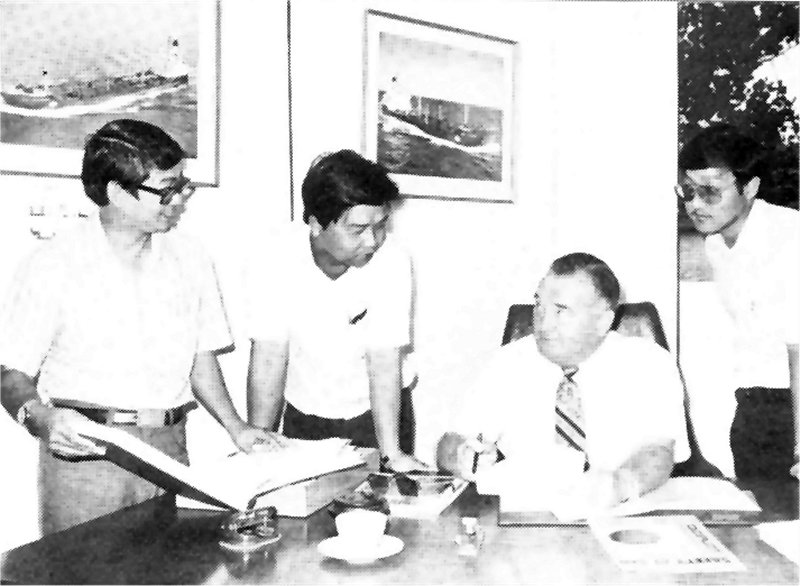Auke Visser's International Esso Tankers site | home
When an Exxon tanker drydocks in Singapore ...
Source : Esso Singapore News, May 1978.
 The "Esso Norway" at Mitsubishi Shipyard.
When the 190,000 dwt Esso Norway drydocked at Mitsubishi Shipyard here last month, the Marine Division of our Marine & Supply
Department was in action behind the scenes.
Marine Division Manager, Ko Breen, told ESN: “This is the first of 13 Exxon Very Large Crude Carriers (VLCC ’s) scheduled for drydocking in Singapore this year.”
 Ko Breen.
Exxon has awarded contracts to three local shipyards to drydock 11 VLCC’s and a mediumsized tanker - ranging from 110,000 to
300,000 dwt » while similar arrangements are being finalized for another two supertankers.
Five other vessels will drydock at Mitsubishi, three at Hitachi and two at Jurong later in the year.
"The drydocking and repair bill including cost of materials is expected to be about S$15 million per vessel," he added.
‘The work, costing a total of about S$ 15 million, represents the bulk of Exxon’s worldwide VLCC regular survey and maintenance."
Exxon tankers and VLCC’s have been drydocking in Singapore since 1973 — each ship being drydocked once in every two years.
Besides the cost-competitiveness of local shipyards, the efficiency and standards here are equal to those of major shipyards around the world, according to Ko.
 The marine agency supervision team: (from left) Sng Ah Kim, Wee Teck Ban, Mum Yasin, Bruno Arrive, Richard Chang, Lim Kim Sang.
Further, Singapore shipyards are favourably located midway between Japan and the Persian Gulf. Owners of vessels such as Exxon can schedule ships to Japan/Okinawa with cleaning and repair taking a Minimum amount of extra time.
“The Exxon/Esso affiliates who own the vessels book the shipyards themselves and assign their own marine superintendents to supervise the drydocking's," he said.
However, during the drydocking's, which may extend from one to three weeks, our Marine Division — comprising the Marine services, and Maintenance and Repairs Sections — provides the necessary planning, coordinating and purchasing assistance.
The Marine Agency Group headed by Agency Supervisor Tan Koon Yam from Marine Services, keeps tab of the overall proceedings involved — from the time the ship arrives to the day she departs.
Port Captain Bruno Arrivo, who is responsible for the Agency Group, recounted:
“We handle all the entry requirements such as obtaining both inward and outward vessel clearance from the Port of Singapore Authority, including the processing of health papers and certificates specific to the marine business.”
Among other activities, Marine Agency Operators Sng Ah Soon and Wee Teck Ban arrange for a chemist to check that the vessel is in a gas-free condition before any cleaning or repair work is undertaken.
Marine Personnel Officer Richard Chang looks after the needs of the crew — including personnel replacement, transport and accommodation, and medical services to monitoring personnel movements in general.
“Most of the foot-work is done by Musa bin Yasin and Lim Kim Song, the Marine Personnel Assistants in the team,” Richard said.
Marine Services Section Head Frank Stille pointed out that the agency’s role is essentially to provide the back-up services as and when required.
 Members of the Maintenance and Repairs Section (from left) Anthony Tang, Ho Yew Weng, Jan Bostelaar, Allan Tea.
The Maintenance and Repair Section, under Jan Bostelaar, primarily provides marine technical assistance. Jan’s staff also helps with activities such as the initial cleaning of the cargo tanks and the purchase of materials.
According to Jan, “As many as a hundred cleaners may be involved in removing some 200 tons of sediment from the cargo tanks before the ship can be drydocked.
“The cleaning bill — which is not included in the drydocking and repair expenses $20,000 will be for stores and provisions.”
Anthony arranges laundry services and supply of films for the ship's crew.
Allan and Johnny also board ships to ensure that orders have been satisfactorily filled and to check with the ship’s officers for any further requirements.
|